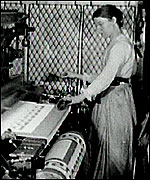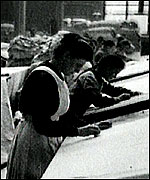| So
whilst England raked in the coffers and revelled in the 'brass', factory workers
in cramped, filthy housing and often dangerous working conditions, were firmly
on the receiving end of the muck! The rapid growth
of the cotton industry demanded an ever increasing work force. Workers
moved out of the country and into the city attracted by the prospect of better
paid jobs in textile production. City slums And
an ever growing work force demanded ever growing accommodation.
 |
| Danger at work - there were numerous health hazards
inside and outside the mill | As towns and
cities sprang up around the factories, living conditions declined. Badly planned,
poorly built slums were seriously overcrowded. Open
sewers and shared privies meant disease was rife and in 1831, Manchester was hit
by a severe cholera epidemic which claimed hundreds of lives. Whilst
living conditions remained a cause of serious concern, the occupational health
risks of factory work soon became apparent to the medical profession. 'A
fair day's pay for a fair day's labour!'
 |
| A long working day | Whilst
modern day workers may rue the nine to five routine, cotton mill workers were
three hours into their 13 our working day by 9am. Long
working days continued throughout the 18th Century and for much of the 19th too. Mechanisation
may have shifted cotton spinning from a craft to an industrial process, but it
came at a cost - a human cost. The noise from machinery
was deafening, many workers became skilled lip readers in order to communicate
over the noise. Ear protection was not compulsory
leading to many workers becoming deaf. Fighting
for breath The air in the cotton mills had to
be kept hot and humid (65 to 80 degrees) to prevent the thread breaking.
 |
| A dangerous job | In
such conditions it is not surprising that workers suffered from many illnesses.
The air in the mill was thick with cotton dust
which could lead to byssinosis - a lung disease. Although
protective masks were introduced after the war, few workers wore them as they
were made uncomfortable in the stifling conditions. Eye
inflammation, deafness, tuberculosis, cancer of the mouth and of the groin (mule-spinners
cancer) could also be attributed to the working conditions in the mills. Long
hours, difficult working conditions and moving machinery proved a dangerous combination.
Accidents were common and could range from the loss of a finger to fatality. Working
for wakes week Life in the mill was harsh and
the only respite came in the form of wakes week, in which the mill would close
for a week or fortnight to allow workers an annual holiday. Those
who could afford it headed to seaside resorts such as Blackpool or Morecambe for
a week, while others would enjoy the delights of the fair on a day trip. Holiday
trains would be specially laid on to cope with the influx of workers and for a
short time, hardships at work were forgotten - almost. Harsh
conditions, unfair practices in the mills provoked demands for reform with mass
protests, strikes, disputes and the growth of trades unions. The
passing of numerous Factory Acts over the years saw a gradual improvement in working
conditions, but life as a mill worker was never an easy one. | 
